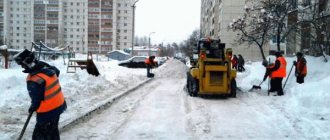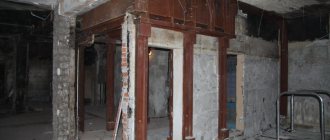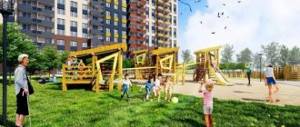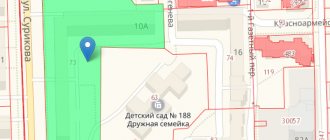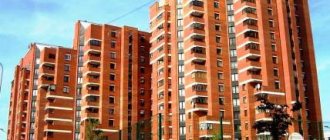When purchasing an apartment, its owner is sure that all rights to the purchased meters belong exclusively to him. But few people think about what happens to the land and the real estate located on it, which is located next to the apartment building.
The adjacent territory is the territory adjacent to a residential building, defined by land management and urban planning documentation within a plot of land of a certain area.
It may contain various structures and non-residential premises necessary to meet the household needs of the residents of this house. Many people are interested in the question of how many meters is the adjacent area of an apartment building in 2021? Read more about this below.
Home improvement and local area
There are no specific standards regulating the exact size of the local area. On average, for an apartment building this equates to 3-6 meters (maybe more).
According to Art. 36 Housing Code of the Russian Federation, the local area includes :
- blind areas (waterproof coverings located around the building);
- driveway, sidewalk, planting strip along the house, as well as the one located near the facade without entrances (its purpose is to provide passage for fire trucks);
- children's playgrounds, sports grounds, as well as those pedestrian paths (paths) that connect these objects to each other;
- areas where waste bins are located;
- plots of land under non-residential commercial buildings and structures;
- parking lots where the cars of residents of an apartment building are parked;
- exits, entrances to underground garages and parking lots.
Size of the adjacent area to the building
The working group to determine the boundaries adjacent to certain organizations and objects of territories where retail sale of alcoholic beverages is not allowed on the territory of the municipal formation of the city of Nizhny Tagil, created by the resolution of the Administration of the city of Nizhny Tagil dated 06/05/2013 No. 1052: 1) at least one once a year, monitor the opening and closing of children's, educational, medical organizations, sports facilities, train stations, markets; — dated November 14, 2013 No. 2720
We recommend reading: Russian citizenship was denied
1) Distance values from children's, educational, medical organizations, sports facilities, train stations and markets to the borders of adjacent territories where retail sale of alcoholic beverages is not allowed (Appendix No. 1); 2) Schemes of the boundaries of adjacent territories to children's, educational, medical organizations, sports facilities, train stations, markets where retail sale of alcoholic beverages is not allowed (Appendix No. 2). Used when calculating distances from children's, educational, medical organizations, sports facilities, train stations and markets to the boundaries of adjacent territories where retail sales of alcoholic beverages are not allowed, circles with a large radius are applied to stationary retail facilities; circles with a smaller radius - in relation to facilities providing catering services.
Registration of property
The only legally accessible and legal option for privatizing the adjacent territory today is the organization of condominium associations (associations of co-owners of an apartment building). It is important to understand that after drawing up the agreement, it does not become the property of the condominium association, but belongs to all co-owners of the apartment building in equal shares.
The condominium association is a legal entity, a non-profit organization, the main objectives of which are to improve the quality of provided public services, manage an apartment building, and rationally operate shared facilities for residents.
The sequence of transferring land into the ownership of condominiums:
- At a meeting of residents, an appropriate decision is made on the privatization of the land around the house;
- Next, you should contact Rosreestr with an application to register ownership;
- When the permission to allocate a land plot and the corresponding technical specifications are ready, you need to go to the land management organization with a package of documents.
How to hold a general meeting of residents in 2021?
What documents will be required:
- certificate of state registration of condominiums;
- the charter of this organization;
- certificate of inclusion in the All-Russian Classifier of Enterprises and Organizations (OKPO);
- technical passport for an apartment building;
- extract from the state register of ownership;
- decision of the members of the condominium association to transfer the adjacent territory to private use;
- land boundary plan.
In turn, the land management organization, based on the land division project and the documents provided by the condominium association, prepares a site allocation project. Next, the city council must decide to transfer the territory near the house to the ownership of the residents of the apartment building and approve the corresponding project.
Based on the results of all the decisions made, the boundaries of the site are drawn to the area, after which a state act on the ownership of residents of the land adjacent to the house is drawn up and entered into the Unified State Register of Rights to Real Estate.
Registration of condominiums and selection of relevant documentation are energy- and financially-intensive activities. However, this procedure has several advantages:
- Residents can independently dispose of the corresponding plot of land, monitor (adjust) the amount of payment for cleaning the local area.
- Privatization allows you to avoid unwanted buildings in the relevant area and use the territory for the needs of the residents of the apartment building.
Size of the adjacent territory to a private house
Another quite pressing problem for many private owners is the improvement of the area adjacent to the building. In this regard, experts recommend drawing up a site plan, distributing objects on it at your own discretion. Landscaping involves a certain set of works. It includes:
- Draw up a plan of the natural border of the territory , with all the objects necessary for the use of a private house marked on it.
- Indicate in the plan a section of the adjacent territory that is property for municipal use and cannot be alienated.
We recommend reading: The service life of panel houses is 80 years
Designation of the adjacent territory in traffic regulations
The concept itself and its explanation are in paragraph 1.2 of the Rules:
Adjacent territory” is the territory directly adjacent to the road and not intended for through traffic of vehicles (yards, residential areas, parking lots, gas stations, enterprises, etc.).
That is, this is a path that makes it possible to drive up to any object (home or business, parking lot, gas station, etc.). But it cannot be used to travel from point L to N if both of them are located outside the adjacent zone.
This section can sometimes be easily confused with an intersection. Some road signs help to distinguish it:
- 5.21 and 5.22. The first signals the beginning of the residential zone, the second - its end.
- 7.3. It is placed where the entrance to the gas station is located.
- 3.2. Prohibits end-to-end following.
- 3.1. Signals that it is forbidden to enter the site through this road.
But the listed symbols are not always installed on the first border of the adjacent zone, they may not exist at all, and you still cannot drive through it. In addition, 7.3 does not exclude the possibility that there is still a roadway in front of the site, where different rules apply. And before entering the adjacent territory, there may be signs that are installed only at intersections:
- 2.1;
- 2.3.1-2.3.7;
- 2.4;
- 2.5;
- 3.16;
- 3.20;
- 3.22;
- 3.24;
- 3.26-3.30;
- 4.11.
Indeed, in GOST R 52289-2004 there is, for example, the following requirement:
It is permissible not to install signs 2.1, 2.3.1-2.3.7 ... before junctions with exit roads from adjacent territories, if all of the listed signs of adjacent roads can be clearly recognized by drivers of vehicles traveling along the main road during daylight and dark hours.
That is, the presence of a sign indicates that this is an intersection. But its absence does not yet indicate that the adjacent zone is adjacent to the main road.
More on AutoLex.Net:
What should be the distance between cars in different situations: in a convoy, at a traffic light, in a traffic jam, about braking distance and reaction time
How to make turns, exit
The main difference between the rules at the intersection and in the adjacent area is that you should leave them differently. When leaving the adjacent territory, traffic rules are determined as follows: when performing it, you must yield to all other traffic participants. Priority is given to cars and other vehicles entering the site or following the road past the intersection. The need is dictated by clause 8.3 of the Rules:
When entering the road from the adjacent territory, the driver must give way to vehicles and pedestrians moving along it...
U-turns from adjacent areas are permitted under traffic regulations. The main condition is that the space should be clearly visible on all sides. Equally important is the absence of signs prohibiting U-turns. It is more convenient to use the adjacent area located to the left of the main roadway. After all, the vehicle turning around on it must yield to all other cars and pedestrians when leaving. And it’s easier to fulfill the condition when you need to turn right.
You need to enter the adjacent zone, turn on the left turn signal, make a maneuver and leave it.
If the adjacent area is to the right of the road, it is better to proceed past the entrance to it and stop about a meter away. Then you need to back up and thus end up in the adjacent territory. In this case, you only need to let pass pedestrians who appear on the path. And when leaving, give way to the vehicle, as indicated in paragraph 8.3 of the traffic rules.
More on AutoLex.Net:
How to drive to the “Main Road” road sign, interpretation, additional symbols
Legal problems
- determining the size and boundaries of the PT;
- nature of use;
- management features.
The fact is that common property belongs to everyone. This means that while a person has the right to use and dispose of property, he cannot do anything alone. All decisions regarding PT are made only by a majority vote at the general meeting.
This is how the peculiarities of managing local areas manifest themselves. At the general meeting, residents decide on the placement of new facilities not included in the project, the allocation of plots for parking, landscaping, and recreational areas.
The main legal problem is determining the boundaries and area of the local area. The fact is that such territories were not allocated for houses of old construction. Yes, some buildings and courtyards did not have, there were only streets and areas like a well. Since buildings built before the nineties of the twentieth century were in state ownership, issues of development of adjacent areas were resolved at the level of local authorities.
For this reason, there are many buildings in cities that formally do not have adjacent areas. Sometimes there is simply nowhere to form them. At the same time, there is a method for calculating PT in accordance with the total area of the apartments of a given building. In order for a house to have its own official local area, property owners need to hold a general meeting (the quorum is two-thirds of the total number of owners), make a decision and contact the municipal authorities with a request to carry out land management work.
Land managers must not only determine the area of the PT, but also mark it on the ground. This will be useful for further actions on the use of land owned by the owners of the apartments of this building. After carrying out the work and receiving the technical plan, a package of documents is submitted to the Rosreestr authorities. If the applicants are denied registration of the PT as part of the property, then such a decision can be appealed in court.
Rules for placing objects
Everything that is located in the local area is a consequence of the implementation of the project, the decision of the residents of the house, or the illegal actions of people who want to benefit. After the house is built and put into operation, the so-called landscaping is carried out. The objects provided for by the project must be handed over along with the house. Everything else is finalized by the owners.
The biggest problem in the courtyards of urban apartment buildings is parking. Older houses were not designed for a large number of cars. Moreover, historical buildings were generally erected without taking into account the availability of personal transport. For this reason, when managing local areas, the organization of parking spaces is of great importance.
Who serves the territory
The fact that the adjacent territory belongs to all apartment owners does not mean that they all service it at once or in turn, although this is also possible. By decision of the general meeting, apartment owners choose a management company that not only ensures the viability of the house, but also maintains the surrounding area in proper order.
The scope of work depends on the agreement between the residents and the management company. However, usually such an organization carries out work on:
- cleaning the area;
- arrangement of recreational areas, including children's playgrounds;
- the formation of areas with green spaces;
- repairing roads in the yard;
- care of all PT facilities.
So, when choosing a management company and concluding an agreement with it, residents need to carefully consider all the points of mutual obligations.
If the local area is not allocated or some of the objects are, by force of circumstances, owned by the municipality or some department, then the general meeting or initiative group will have to interact with the management of the institutions, forcing them to take the necessary actions. If there is no provision in the agreement for maintenance, for example, of the road and sidewalks, the issue of a one-time event to pay for road repair work at the expense of the residents of the house will have to be put on the agenda of the general meeting.
This is important to know: How to get out of SNT if you own land: procedure and consequences
You will have to equip the yard with video cameras yourself. To do this, you can enter into an agreement with an organization working on the “safe yard” project. The agreement can be concluded either with an individual or with the owners of several apartments. The advantages of this project are that with the help of a video camera placement system it is possible to cover almost the entire local area with round-the-clock surveillance.
Penalties for violating traffic rules in the surrounding area
Driving through these areas is carried out in accordance with the Traffic Rules. And since they exist, it means that there are penalties for violating them.
Thus, parking lots and gas stations, or rather, their entrances and exits, are marked with road signs. Therefore, if a vehicle passes in the opposite direction, then this is regarded as driving in the oncoming lane. For this offense, the driver may lose the ability to drive a car for six months or be required to pay a fine of five thousand rubles.
Sometimes a prohibitory sign is installed at the intersection of the adjacent territory and the roadway. It refers to the road. Failure to comply with the rules will result in a fine of five hundred rubles.
In the adjacent territory, the ban on through passage is most often violated. For this offense, the driver will be punished with a fine of one and a half thousand rubles.
Other violations in the adjacent territory are fraught with the same consequences as failure to comply with traffic rules on other sections of the road: exceeding the permissible speed, driving while intoxicated, and so on.
In the parking lot, there is a possibility of being fined if you occupy a disabled space. If the vehicle of a person with disabilities is not marked with a special sticker, he will also be punished.
New law on land acquisition 2021
Laws in the field of land management and cadastre have undergone active changes in recent years. The new law on the addition of land plots, effective in 2021, is a whole layer of rules affecting the formation of land plots. At the beginning of 2019, Federal Law 217 on horticulture came into force, changing the basic concepts and definitions of summer cottages. On June 17, 2021, a new law 150-FZ was adopted, amending the laws on cadastral activities and real estate registration (218-FZ and 221-FZ). The changes concern complex cadastral works: the procedure for carrying them out is simplified, while it remains possible to increase the land plot up to 10% of its total area if, during the complex cadastral works, it turns out that in fact the plot is larger than on paper. The State Duma is also considering a number of amendments to simplify the procedure for registering land plots and buildings (the dacha amnesty will be extended until 2022).
Only the owner can add additional acres to his plot. Tenants of land plots, as well as persons who own land plots for free use, do not have this opportunity.
How to register the addition of a land plot in accordance with the Land Code
The Land Code does not contain such a concept - the addition of a land plot. Redistribution of land plots is commonly called redistribution. According to the general rules for the formation of land plots (Article 11.2 of the Land Code), there are several types of formation of new land plots:
- Allocation;
- An association;
- Redistribution;
- Chapter.
In the article we will not consider each of these types in detail, but we will talk in more detail about redistribution, or more precisely about how the addition of a land plot in 2021 occurs due to the area of adjacent lands, and how the size of a land plot can be legally increased.
